Spring break is here in Houston, but the weather doesn't' give us a break today with humidity reaches nearly 90% and temperature is top 85. Living in Houston for almost 8 years now but I don't really explore it much. So I decided to pay Houston's museum district a visit this weekend to learn more about Houston and take some pictures around.
The Houston Museum district is one of the two main recreational districts in Houston. The other one is Theater District housing visual performance art shows and exhibit. The district is centered on the pink-colored Wyndham-Warwick Hotel and the adjacent Mecom Fountain. The Museum District also houses Rice University, the Clayton Library Center for Genealogical Research and Hermann Park which includes the Houston Zoo and the Miller Outdoor Theatre. The Museum District is also near the University of Saint Thomas. Some of the museums include:
- The Holocaust Museum
- Houston Children Museum
- Houston Children Museum
- Houston Museum of Health and Medical Science (located in the medical center. Houston's Hermann Cancer Center is the world's the largest and most modern, state-of-the-art cancer center.)
- Contemporary Arts Museum
- and the Museum of Fine Arts


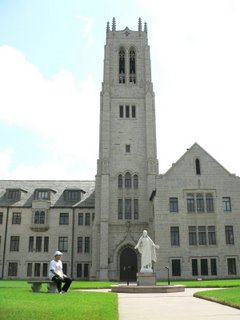 The I stop for a bit at the museum of fine arts. This museum has all kind of collections from different periods of art history. Last year they hosted a collection of masterpeices from the Impressionism. Those include paintings of Picasso, Monet and Van Gogh. Needless to say, I had to wait in the line for hours before stepping into the museum to witness those mutil-million dollar artwork. This is from the collection of classical antiquity period:
The I stop for a bit at the museum of fine arts. This museum has all kind of collections from different periods of art history. Last year they hosted a collection of masterpeices from the Impressionism. Those include paintings of Picasso, Monet and Van Gogh. Needless to say, I had to wait in the line for hours before stepping into the museum to witness those mutil-million dollar artwork. This is from the collection of classical antiquity period: The unknown Emperor: cast bronze, found and excavated from a wrecked ship in Atlatic Ocean

This one i think was taken from one of the Delphi temple in Acropolis, Athen :-).
Yeah... we all stole from them Greek.

Early stone statue version of Venus (Aphrodite). Most of modern sculpture based their work on this style of posture.

This reminds me of my art history class taken a few years ago. The form of classical sculpture became fluid and natural and the stylization of the archaic art gave way to realistic figures which emanated the illusion of moving through space. For the first time in human history, human anatomy was deemed worthy of being immortalized in stone or bronze. And the Greek did it. They worshipped the human body. Gods were as human asn us, but they were just immortal. And gods did have sins and flaws too. What a monumental contradiction point of view!
During the classical period the Greek artists replaced the stiff vertical figures of the archaic period (like Egyptian's sculpture if it could help you to visualize better) with three-dimensional snap shots of figures in action. While the archaic sculptures appeared static the classical statues held dynamic poses bursting with potential energy. The overall patterns of immobile muscles were developed into a complex universe of tension and relaxation. The ancient Greek sculptors had finally achieved balance through the opposing action of the human muscle groups. Most of Greek sculpture in this period involved around a unique technique called contrapposto: The appearance of weight shift in sculpture by the depiction of counter-positioning, in which the body relaxes on one side as the other side takes on the weight of the body and tenses up.
Like this one form the modern age:
 There are also lots of paintings from the 15th century.
There are also lots of paintings from the 15th century.
During the classical period the Greek artists replaced the stiff vertical figures of the archaic period (like Egyptian's sculpture if it could help you to visualize better) with three-dimensional snap shots of figures in action. While the archaic sculptures appeared static the classical statues held dynamic poses bursting with potential energy. The overall patterns of immobile muscles were developed into a complex universe of tension and relaxation. The ancient Greek sculptors had finally achieved balance through the opposing action of the human muscle groups. Most of Greek sculpture in this period involved around a unique technique called contrapposto: The appearance of weight shift in sculpture by the depiction of counter-positioning, in which the body relaxes on one side as the other side takes on the weight of the body and tenses up.
Like this one form the modern age:
 There are also lots of paintings from the 15th century.
There are also lots of paintings from the 15th century.Last supper, Sebastiano Ricci


The mocking of Christ, Tintoretto . Notice the red circle i draw here. This bearded figure standing in the background is probably his self-potrait, so that the artist witnessed Christ's torment on a personal level.

Get out of the museum, I perambulate to the Hermann park at the heart of the museum district throuh a semi-circular fountain. There are actually three consecutive ones, but I can only manage to have one in this snapshot
 Hermann Park look from Terrance Plaza
Hermann Park look from Terrance Plaza
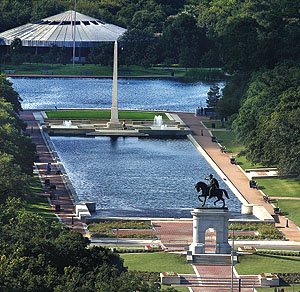 The Sam Houston Monument and Circle frame the Heart of the Park's north end; the area known as the Lake Overlook, which fronts Hermann Park's McGovern Lake, forms the south end.
The Sam Houston Monument and Circle frame the Heart of the Park's north end; the area known as the Lake Overlook, which fronts Hermann Park's McGovern Lake, forms the south end.
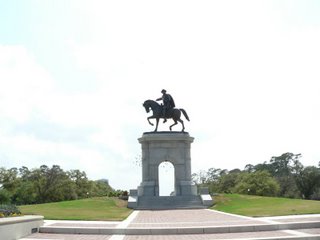

The Heart of the Park's central and most prominent feature – the 740-foot-long and 80-foot-wide Mary Gibbs and Jesse H. Jones Reflection Pool – is flanked by two pedestrian plazas that are situated between the Sam Houston Circle and the Lake Overlook. Bordered by 80-year-old live oak trees, shaded walking paths of decomposed granite, and groupings of new benches, the Pool also features a cascade created by the gentle flow of water down a series of stepped surfaces. Its black bottom was designed to enhance the water's reflectivity.
Reflection Pool look from the main entrance North - South


Located by the left side of the park is a Japanese garden.
From what I have learned this particular garden is a daimyo style, and includes a tea garden, a kaiyushiki stroll garden, and a scroll garden.
The entry garden is a dry landscape garden.
japanses garden often mimics nature. Thus, the garden itself represents a mini ecosystem, lanscape. Stones are islands, streams are rivers. The design of the garden also has to follow certain feng-shui rules.

Imagine you are standing on the sea (black moonstone) and the boulders are the rising landscape of Japan. The bamboo flowing in the wind represents the sound of the ocean.
 Through the gate straight ahead there is a welcoming lantern, a gift from the city of Chiba, Japan. This five-piece lantern was carved from solid granite. The aperture of the lantern focuses the spirit of the garden. There are three stone lanterns, ishi-doro, in this garden.
Through the gate straight ahead there is a welcoming lantern, a gift from the city of Chiba, Japan. This five-piece lantern was carved from solid granite. The aperture of the lantern focuses the spirit of the garden. There are three stone lanterns, ishi-doro, in this garden.
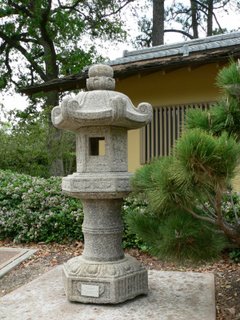
 Stone lanterns play a significant role in Japanese gardens. They represent time. Usually, there are several lanterns are placed in a garden to remind visitor of the time present.
Stone lanterns play a significant role in Japanese gardens. They represent time. Usually, there are several lanterns are placed in a garden to remind visitor of the time present.
Curved pathways in the garden are covered with crushed stone similar to moonstone. The arbor is a place to sit, meditate and clear the mind of other thoughts. It is also special place to wait until called to tea ceremony in the teahouse.
 Before entering the teahouse, tea ceremony guests walk along this path which the host will have moistened to appear damp with morning dew. This path is hence called the dewy path or roji.
Before entering the teahouse, tea ceremony guests walk along this path which the host will have moistened to appear damp with morning dew. This path is hence called the dewy path or roji.
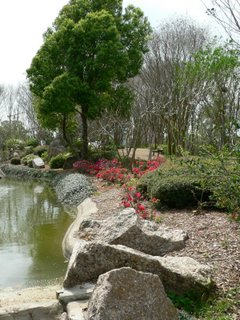


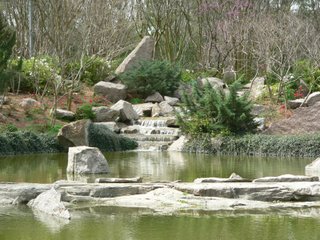
Next month, April 7 - 8 is the tranditional Japan festival. Our dojo will put on a show at Hermann park on those days. Some of the activities are rice pounding, Kendo and Iaido performance. Come here again to see my post for the event!
This is the miniature railroad running across the park. The railroad covers almost 100% of the park's circumfence and also there are seperate tracks running across the park.
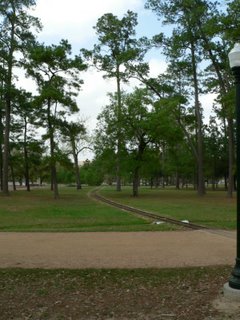

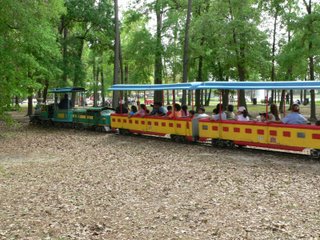
Perhap you and your special someone can pedal the swan boat on this 21 -arces McGovern Lake. Boats are for rent at $7 per hour.

In the middle of the park is a 35-foot high hill. Frisbee can be played here or you can just run up and down 'til you pass out.

So many pine trees... and green grass

Or... practice your acting skills onstage at Miller Outdoor Theatre
That's it for now... phewww.... I'll be back next time with photo from Japan Festeval (also in here Hermann park).
 Hermann Park look from Terrance Plaza
Hermann Park look from Terrance Plaza The Sam Houston Monument and Circle frame the Heart of the Park's north end; the area known as the Lake Overlook, which fronts Hermann Park's McGovern Lake, forms the south end.
The Sam Houston Monument and Circle frame the Heart of the Park's north end; the area known as the Lake Overlook, which fronts Hermann Park's McGovern Lake, forms the south end.

The Heart of the Park's central and most prominent feature – the 740-foot-long and 80-foot-wide Mary Gibbs and Jesse H. Jones Reflection Pool – is flanked by two pedestrian plazas that are situated between the Sam Houston Circle and the Lake Overlook. Bordered by 80-year-old live oak trees, shaded walking paths of decomposed granite, and groupings of new benches, the Pool also features a cascade created by the gentle flow of water down a series of stepped surfaces. Its black bottom was designed to enhance the water's reflectivity.
Reflection Pool look from the main entrance North - South

Look from South - North

Located by the left side of the park is a Japanese garden.
From what I have learned this particular garden is a daimyo style, and includes a tea garden, a kaiyushiki stroll garden, and a scroll garden.
The entry garden is a dry landscape garden.
japanses garden often mimics nature. Thus, the garden itself represents a mini ecosystem, lanscape. Stones are islands, streams are rivers. The design of the garden also has to follow certain feng-shui rules.

Imagine you are standing on the sea (black moonstone) and the boulders are the rising landscape of Japan. The bamboo flowing in the wind represents the sound of the ocean.
 Through the gate straight ahead there is a welcoming lantern, a gift from the city of Chiba, Japan. This five-piece lantern was carved from solid granite. The aperture of the lantern focuses the spirit of the garden. There are three stone lanterns, ishi-doro, in this garden.
Through the gate straight ahead there is a welcoming lantern, a gift from the city of Chiba, Japan. This five-piece lantern was carved from solid granite. The aperture of the lantern focuses the spirit of the garden. There are three stone lanterns, ishi-doro, in this garden.
 Stone lanterns play a significant role in Japanese gardens. They represent time. Usually, there are several lanterns are placed in a garden to remind visitor of the time present.
Stone lanterns play a significant role in Japanese gardens. They represent time. Usually, there are several lanterns are placed in a garden to remind visitor of the time present.Curved pathways in the garden are covered with crushed stone similar to moonstone. The arbor is a place to sit, meditate and clear the mind of other thoughts. It is also special place to wait until called to tea ceremony in the teahouse.
 Before entering the teahouse, tea ceremony guests walk along this path which the host will have moistened to appear damp with morning dew. This path is hence called the dewy path or roji.
Before entering the teahouse, tea ceremony guests walk along this path which the host will have moistened to appear damp with morning dew. This path is hence called the dewy path or roji.



Next month, April 7 - 8 is the tranditional Japan festival. Our dojo will put on a show at Hermann park on those days. Some of the activities are rice pounding, Kendo and Iaido performance. Come here again to see my post for the event!
This is the miniature railroad running across the park. The railroad covers almost 100% of the park's circumfence and also there are seperate tracks running across the park.



Perhap you and your special someone can pedal the swan boat on this 21 -arces McGovern Lake. Boats are for rent at $7 per hour.


In the middle of the park is a 35-foot high hill. Frisbee can be played here or you can just run up and down 'til you pass out.

So many pine trees... and green grass


Or... practice your acting skills onstage at Miller Outdoor Theatre

That's it for now... phewww.... I'll be back next time with photo from Japan Festeval (also in here Hermann park).

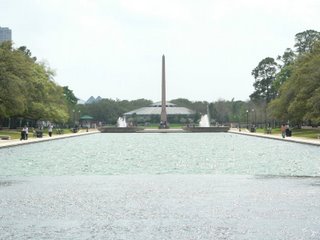




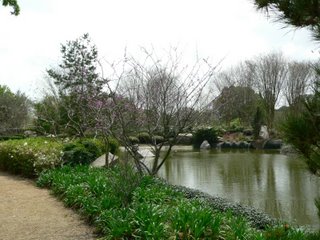
2 comments:
This is a very infomative article. I have lived in Houston for almost 20 years and I did not relized all the hidden treasures around the museum district. I look forward to reading more blogs from you about Houston.
Yep... same thing for people.
You sometimmes have to look at a person with dedication in order to find the "hidden" values from that person.
"There wouldn't be no Alamo,
No Cowboys in the Superbowl:
No "Lonesome Dove", no "Yellow Rose",
If it wasn't for Texas.
I wouldn't be a Willie fan.
Nobody'd swim the Rio Grande.
I wouldn't be an American,
If it wasn't for Texas."
Post a Comment